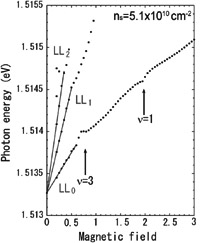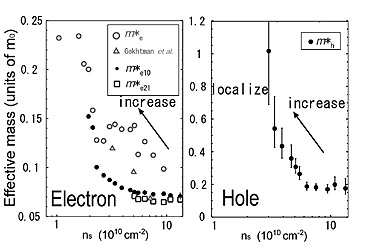1Physical Science Laboratory, 2CREST-JST, 3University of Tsukuba/NTT Research Professor
Several scattering mechanisms, such as scattering by surface charge
and by donor ions, interfacial scattering, and the impurity scattering,
limit the electron mobility of semiconductors. In the case of the conventional
semiconductor hetero-junction, the scattering by donor ions at the doped
layer causes an unavoidable reduction of the electron mobility at low electron
density. The enhancement of the electron effective mass or the increase
in the spin susceptibility, which has been observed by the Subnikov-de
Hass oscillation measurements at low electron density, is attracting much
attention in the semiconductor physicists. However, it is hard to observe
them with low-mobility samples since these phenomena are induced by electronelectron
interaction. Because our gated undoped quantum well has no donor layer,
a high mobility is maintained even at low electron density and the electron
density can be controlled continuously by the gate bias. In addition to
conventional electric transport measurements, we performed photoluminescence
measurements over the insulator to metallic regime by changing the electron
density (ns). We determined the electron and hole effective masses within a wide range
of the electron density [1].
The electron and hole effective masses in the low magnetic field regime
were obtained from the Landau level splitting of the photoluminescence
peaks (Fig. 1). An increase of the electron effective mass with decreasing
electron density was obtained at ns< 1×1011 cm-2 (Fig. 2). Moreover, we found that the hole effective mass also increases
with decreasing electronic density and that the hole is localized at ns< 3×1010 cm-2.
Using this gated quantum well, we are exploring the spin polarized
state predicted to appear due to the electron-electron interaction in ultralow
electron density.
[1] S. Nomura, et al., Phys. Rev. B 76 (2007) 201306R .
 |
 |
||||
|
|